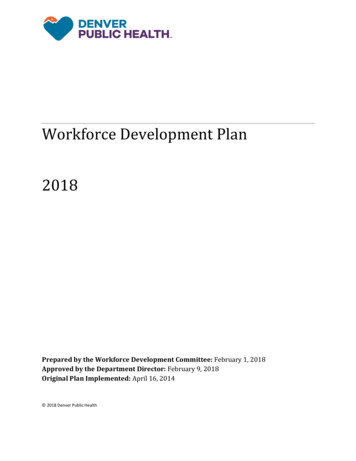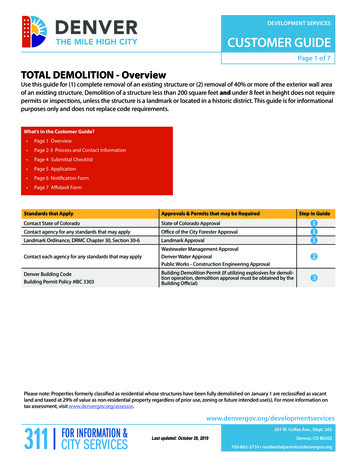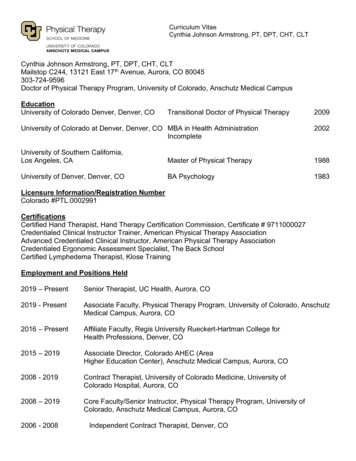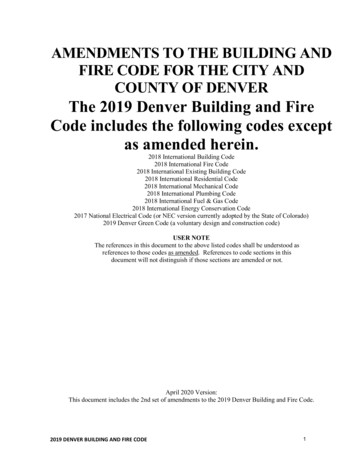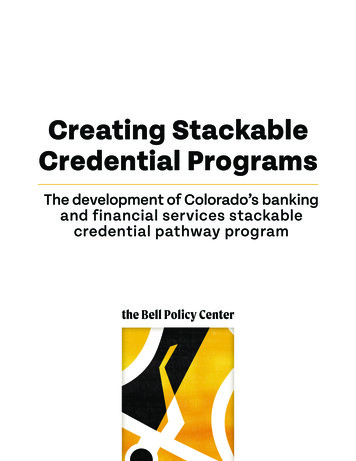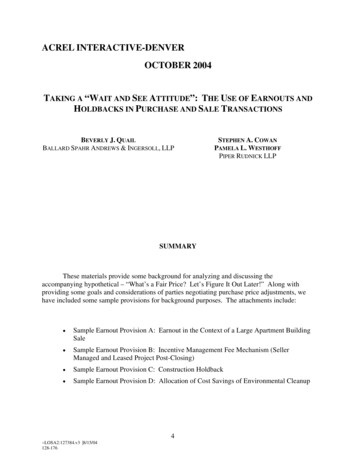
Transcription
ACREL INTERACTIVE-DENVEROCTOBER 2004TAKING A “WAIT AND SEE ATTITUDE”: THE USE OF EARNOUTS ANDHOLDBACKS IN PURCHASE AND SALE TRANSACTIONSBEVERLY J. QUAILBALLARD SPAHR ANDREWS & INGERSOLL, LLPSTEPHEN A. COWANPAMELA L. WESTHOFFPIPER RUDNICK LLPSUMMARYThese materials provide some background for analyzing and discussing theaccompanying hypothetical – “What’s a Fair Price? Let’s Figure It Out Later!” Along withproviding some goals and considerations of parties negotiating purchase price adjustments, wehave included some sample provisions for background purposes. The attachments include: Sample Earnout Provision A: Earnout in the Context of a Large Apartment BuildingSale Sample Earnout Provision B: Incentive Management Fee Mechanism (SellerManaged and Leased Project Post-Closing) Sample Earnout Provision C: Construction Holdback Sample Earnout Provision D: Allocation of Cost Savings of Environmental Cleanup4 LOSA2:127384.v3 8/15/04128-176
OUTLINEOne of the most rewarding experiences we have as real estate lawyers is the chance tocreatively solve problems for our clients. Although sometimes the deal is struck before we areasked to document it, we all love the opportunity to jump in the trenches from the beginning andwork side by side with our clients to structure a deal that satisfies the business goals of all theparties to the deal, while best protecting our clients.In reviewing alternative structures, we: Establish, as best we can, the ultimate business goal of each party to the deal. Consider the relative leverage of the parties. Who wants or needs the deal more?What is their respective motivation; their respective Achilles heel? Get out your crystal ball – the good one, and the one borrowed from the doomsayer.Think about what could go right (with the real estate market, the economy, globalevents and the financial strength of each party) and what could go wrong (considerinterest rates, world events, political upheaval, etc.) Assess your client’s appetite for risk and the risk-taking inclinations of the otherparties to the deal. How much risk is everybody willing or able to take? Are thereother ways to manage the risk (insurance, bonds, guaranties, termination rights,buyout rights, use of escrows, etc.)? Take note of lessons learned from the various areas of the law that impact thetransaction and each deal point considered. Examples include considering how thebankruptcy of one party might impact the deal or the forward-looking solution; howrelevant environmental laws will allocate the blame and who will be chased; who hasthe deeper pocket and whose pocket is the most accessible (or how do you make theirpocket accessible?).All of these considerations, and more, come into play in the context of a sophisticatedpurchase and sale deal. Often real estate attorneys in an acquisition or disposition transactionwill be called upon to assist in structuring some of the most essential economic terms of the deal.And this is where the fun can really start! While keeping our “attorney hats” firmly on ourheads, we venture into the world of business, trying on our “client hats,” considering the “whatifs” and making recommendations that will (hopefully) enable the deal to go forward and theparties to walk away (relatively) happy.Although agreeing upon the purchase price is most typically the domain of clients,lawyers are often called upon to assist in purchase price negotiations that have a twist –something unique or challenging that provides the platform for “outside the box” thinking andstructuring. Earnouts and holdbacks are one avenue for this type of legal creativity.What is An Earnout?Although earnout structures have become more commonplace in the world of real estatedeals, they have their origins in the arena of corporate law. Frequently used in the merger and5 LOSA2:127384.v3 8/15/04128-176
acquisition context, an earnout is the negotiated mechanism which allows a Seller to “earn” anincreased purchase price post-closing based upon how well the business does in the future. Thistechnique is used to resolve the inevitable disagreement of Buyer and Seller as to how the targetbusiness will perform in the future. In essence, if the acquired company is successful in reachingits revenue or profit targets, the earnout will provide additional post-acquisition considerationeither in cash, stock, partnership units or another agreed upon form of remuneration. By nature,this arrangement also provides incentive for the Seller to support and continue to build or assistin building the business.Structuring an Earnout in a Real Estate DealDespite the difference in context, many of the guiding principles of earnouts in the M&Acontext are directly applicable to a real estate purchase and sale transaction. The following aresome of the primary considerations (including the potential gains and pitfalls) in structuring anearnout: Typically the best transactions for earnouts are those in which uncertainty is inherentand cannot easily be overcome. Perhaps the most prevalent context is a newlyconstructed project. In the case of a project which is nearly or recently completed,the Seller will most likely have optimistic projections for future performance, whilethe Buyer will have a more conservative view. In this situation, an earnout is a meansto inject an element of “fairness” into the deal, providing a form of insurance to theBuyer, and lending comfort to the Seller that money has not been left on the table. Earnout targets must be specific and realistic. If an earnout target differs wildly fromreality, litigation is likely to ensue. There will be finger pointing and allegations ofinterference, misrepresentation and other bad conduct. The parties will need to spendtime analyzing professional data, supporting their own projections and taking abalanced view of the range of likely performance. The parties must carefully evaluate the merits and disadvantages of having the Selleror Seller’s representatives involved in property activities (most likely leasing) postclosing. The level of involvement may vary greatly, ranging from general participation inleasing meetings, to retaining the Seller as the manager and leasing agent for theProject. If you represent the Seller, you need to think through the various events orcircumstances that might result in the Seller’s inability to receive the earnout amountthat is due. Consider such factors as whether the entity agreeing to pay the earnout isa single purpose entity, whether the property is just one of many assets held by theBuyer and whether the Buyer is an entity such as a REIT. Run through a possiblebankruptcy scenario, or the impact of a large judgment against the Seller entity.Should the Seller’s obligation to pay the earnout be secured? If so, consider thealternatives for security. Consider a foreclosure scenario. Should a memorandum of the earnout arrangementbe recorded prior to the lien of a new deed of trust? If the acquisition is financed, the6 LOSA2:127384.v3 8/15/04128-176
lender’s review and approval of the earnout structure is crucial. In some deals, theearnout component of the purchase price will dovetail with the ability of theBuyer/Borrower to obtain an additional disbursement of the loan to pay the earnoutamount due. This comes into play when the project becomes leased up and thereby“earns additional principal” that the lender was originally unwilling to disbursebecause of the uncertainty of project performance. Accountants should also be consulted when structuring earnouts along with anyunique tax treatments affecting the parties. For example, both Buyer and Sellershould run numbers through the earnout formula and consider the tax result based ontheir respective governing accounting standards. Another earnout structure that may be considered is a partnership in which the partyresponsible for leasing (often the original developer of the Project) will “earn”additional partnership interest (or operating units in the case of a REIT). Thisstructure raises an additional set of issues to consider and resolve, such as rulesgoverning partnership, rules governing the granting of REIT interests and the taxtreatment of these transferred interests from the perspective of both parties.What is a Holdback?In the simplest of terms, a holdback is the mechanism by which a Buyer retains a portionof the previously agreed upon purchase price. The parties negotiate and agree upon a set ofspecific conditions that must be satisfied before all or a portion of holdback amount will bereleased to the Seller.A holdback arrangement can be used to resolve myriad issues, and can cover both knownand unknown risks. For example: If the Seller has made a number of covenants, representations and warranties, and is asingle purpose entity that plans to dissolve following the closing of the sale, theholdback provides the Buyer with comfort that it will have a “basket” to go after inthe event of a breach by Seller. A holdback is commonly used to hold an agreed upon sum at bay pending resolutionof an ongoing dispute or legal proceeding, the outcome of which will affect the value(i.e., the fair purchase price) of the property. Examples of this include a pendingarbitration with a major tenant with respect to the rental to be paid during anextension term, a dispute with a contractor regarding a warranty or a proceeding withthe City to determine whether a project expansion will be approved. Holdbacks are often used to address a known contamination issue at a project, such asmold, legionella or soil or groundwater contamination. This may come into play inthe course of a government enforcement action. If an approved cleanup plan ispending, the parties will not know exactly what level of cleanup will be required.Even if the scope of the required cleanup is known, the actual cost of cleanup will beimpossible to quantify. In this case, the parties may agree to allow the Seller to holdback an amount equal to the “worst case scenario” cleanup costs or the mid-rangeestimate, depending upon the relative leverage of the parties. Environmental cleanup7 LOSA2:127384.v3 8/15/04128-176
insurance policies may also be used as a means to put parameters around the amountsat issue. Holdbacks can also serve as “insurance” to backup an indemnity given by the Sellerto the Buyer.How to Structure a HoldbackThere are several purchase and sale agreement scenarios in which either a holdback or anearnout will work. In considering the best approach for any given transaction, the parties willconsider: The tax positions of the parties. For example, would the Seller rather have a lowerstated purchase price, and recognize incremental gain in a future tax year, as with aninstallment sale? The concerns of the party who is to receive more money or be entitled to a refundwith respect to whether the party obligated to pay or refund will actually have themoney to perform. The events or circumstances which might lead to the holdback funds not beingavailable even if the Seller is entitled to it. In this regard, the parties will also chooseto put the holdback funds into a third party escrow. If an escrow is used, the partiesmust enter into a tri-party agreement with the escrow holder to stipulate the terms andconditions of the release of the funds. The parties should consider when the holdback funds are deemed earned. If abankruptcy event affects the Buyer, the Seller will want to be sure that the holdback isnot still considered the property of the Buyer and therefore subject to being deemed apart of the bankruptcy estate. In this regard, bankruptcy counsel may consider acontingent promissory note structure or another structure that will best protect againstsuch unintended results. In some cases, a Seller may be asked to post a letter of creditin the amount of the holdback and the parties will agree upon certain conditions thatmust be satisfied before the Seller is entitled to draw upon the letter of creditrepresenting the remainder of the purchase price.Other Purchase Price AdjustmentsThe foregoing discussion provides just a sampling of the issues to be weighed andconsidered in the context of creatively resolving a disagreement regarding how much money aSeller should receive on a current basis when she sells her property. In addition to earnouts andholdbacks, creative lawyers may consider numerous other mechanisms to address the specific,and often quirky, features of a deal. The dynamics of the relationship between the parties willalso influence how a deal is structured. Factors such as how well the parties trust one another,how well they know the property, the level of risk interest in the price adjustment factor at issue,and their comfort with the financial strength of the party obligated to deliver future performance,will all be evaluated.8 LOSA2:127384.v3 8/15/04128-176
Practice TipsAlthough not intended to be an exclusive list, some issues to keep in mind whenstructuring a purchase price adjustment mechanism include: Consideration of the relative leverage, credit strength and goals of the parties. Taking into account the nature and magnitude of the issue that is the basis for aholdback, earnout or other adjustment. What are the risks? Who can best control the risks? Is there another means to control the risk: insurance, guaranty, etc.?Do a “worst case scenario” analysis. How will certain events impact the intendedresults? Bankruptcy of either party Casualty or condemnation Foreclosure or other lender action Poor project performance Environmental conditions, or those much worse than already considered Zoning or other entitlement; activity at neighboring properties Consideration of tax treatment and special tax positions. Special twists may include a1031 exchange context or a tenant-in-common structure. If using an earnout, take special care with drafting the formula. Use mathematicalformulas and examples where possible. Avoid any calculation which is based onsubjectivity. If implementing a holdback, specifically define the conditions to release of theholdback. Consideration of the control aspects. Who controls the success or failure of theproject? How can the power be shifted or neutralized? Use an escrow where appropriate. If an escrow is used, use a reputable andfinancially stable escrow holder and a clear and well thought out escrow agreement.Don’t just rely on the escrow holder’s standard form agreement. Ideally, incorporatethe escrow terms into the purchase agreement and have the escrow holder sign toacknowledge the terms of the escrow. This avoids confusion and the need tonegotiate an additional, possibly contradictory, agreement. If the calculations at issue are to be controlled by one party, add an audit and reviewmechanism so the party entitled to the funds can double check and, if necessary,challenge the calculations.9 LOSA2:127384.v3 8/15/04128-176
Analysis of potential defaults and remedies. What if a party fails to perform asrequired? What recourse will the other party have? How can performance beappropriately incentivized or forced? Incorporate a dispute resolution mechanism. The parties should agree upon anothermeans to resolve how much is earned in the earnout or how much of the holdbackshould be released. Most parties will choose to set up their own detailed mechanism,using sophisticated and experienced consultants or accountants, rather than simplyrelying upon American Arbitration Association or JAMS rules and procedures. Oftenthe calculations are technical and require an experienced practitioner who understandssophisticated real estate deals. Consider the need for confidentiality. In the context of pending litigation orgovernmental enforcement, there may be a multitude of reasons why the agreement ofthe parties to allocate risk and provide a party with the potential for financial gainmust be kept private and not disclosed.ConclusionEarnouts, holdbacks and other means of adjusting a purchase price can be a fun andcreative means for real estate lawyers to assist in structuring a deal that achieves client goals andmeets client expectations. Consideration of the foregoing will enable practitioners to avoid thepitfalls and achieve success for their clients.10 LOSA2:127384.v3 8/15/04128-176
SAMPLE EARNOUT PROVISION A:EARNOUT IN THE CONTEXT OF A LARGE APARTMENT BUILDING SALE1.TOTAL PURCHASE PRICE AND DEPOSIT(a)The total purchase price for the Property is as follows (the “PurchasePrice”):.(d)The Earnout Amount, if any, calculated in accordance with thisSection 2(d), shall be due and payable sixty (60) days after the Earnout Date (as defined below).The Earnout Amount shall be calculated as the lesser of (x) or (y) the amount equalto the Final Gross Price less , but in no event shall the Earnout Amount be lessthan zero dollars ( 0.00). The Final Gross Price shall be calculated as follows:(i)Final Gross Price equals Annual Net Operating Income divided by.0825.(A)Annual Net Operating Income equals Annual Rent Incomeplus Other Income, less Management Fee, Operating Expenses, Property Taxes and Insurance,calculated pursuant to GAAP consistently applied, using the accrual method and in accordancewith normal and usual practices in the real estate industry.(B)Annual Rent Income equals the total rental income (on anaccrual basis) for all residential and commercial leased space in the Property (excluding any pre–paid rent that is not applicable to this time period) during the Calculation Period (as definedbelow); provided, however, that Annual Rent Income shall in no event be greater than theproduct of (1) the total rental income which would be received under such leases at an assumed100% occupancy level during the Calculation Period, utilizing the actual rental rates in effect onthe Earnout Date, less concessions, multiplied times (2) 97.5%.(C)Other Income equals the amounts with respect to andactually billed or earned during the Calculation Period from all sources, including, but notlimited to, interest income, forfeited deposits, late charges, pool and health club charges, parkingfees, storage fees, private cable, video and vending income, insufficient funds fees charged totenants for NSF checks, pet fees, application fees, lease or license fees for antennas and privatetelephone income, taking into account only the pro rata annual amount of any income which maybe received during the Calculation Period, but which relates to a longer period of time, and thenmultiplied by 97.5%.(D)Management Fee equals an amount not greater than 4%times the sum of Annual Rent Income plus Other Income, calculated using the accrual basis.A-1 LOSA2:127384.v3 8/15/04128-176
(E)Operating Expenses equals all ordinary, necessary andreasonable operating expenses, including, but not limited to, Insurance premiums, for theProperty, calculated using the accrual method of accounting for the Calculation Period, whetheror not paid during the Calculation Period, and bad debt expenses (defined as rental delinquenciesin excess of 90 days). All work performed by third party contractors on the Property shall onlybe performed by contractors who meet the insurance requirements set forth in Exhibit Wattached hereto and incorporated herein. Included in Operating Expenses as an additionalexpense shall be an amount for reserves equal to per unit ( total) per year.The categories of the Operating Expenses for the Property shall be determined based on a budgetprepared by or o behalf of Purchaser substantially in the form attached hereto as Exhibit V,conformed to be specific to the Property (the “Budget”). Operating Expenses shall not includethe following:(1) Property Taxes;(2) the cost of any item for which Purchaser shall becompensated therefor by the net proceeds of any insurance or other compensation from a thirdparty, other than a tenant of the Property;(3) depreciation and other non–cash expenses;(4) non–recurring expenses or one–time charges not includedin the Budget;(5) costs for repairs, other than normal and usual ordinary andnecessary repairs, which, under generally accepted accounting principles should be capitalizedand which exceed 1,000; provided, however, that any repair caused by damage due to the actsor neglect of a tenant of the Property, the cost of which is to be paid for by forfeited securitydeposit funds, shall not be capitalized;(6) legal and accounting fees and charges related to thepurchase of the Property by Purchaser;(7) expenses relating to the calculation of the Earnout Amountor resolution of any dispute under Sections 1(d)(v), (vi), (vii) or (viii) below;(8) interest expense;(9) debt service; and(10) income taxes.(F)Property Taxes equals the actual real estate taxes assessedagainst the Property for real property taxes payable to [SPECIFY COUNTY] any and allapplicable school districts, boards or bodies, fire districts, water districts and all othergovernmental or quasi–governmental bodies or units with taxing authority over the Property,including for libraries and open space funds, as set forth on the official tax bill applicable to theA-2 LOSA2:127384.v3 8/15/04128-176
Property for a full calendar year utilizing the actual tax bill issued by Williams Township basedon a fully assessed property.(G)Insurance equals the actual premium charged to theProperty to obtain and maintain a policy or policies of insurance for the following coverageduring the Calculation Period:(1) licensed to provide insurance in the State of Illinois with arating by A.M. Best of A-X or better.(2) As applicable to the Property and the operation thereofduring the Calculation Period, those coverages in the minimum amounts with the respectiveparameters (including maximum deductibles) as outlined in Exhibit X attached hereto andincorporated herein.(ii)The Earnout Amount shall be calculated based on four consecutivecalendar quarters (the “Calculation Period”). Purchaser shall cause its manager todeliver to Seller, simultaneously with delivery to Purchaser, all reports that the PropertyManager is required to deliver to Purchaser under the Property Management Agreement.Purchaser shall also deliver or cause to be delivered to Seller within forty–five (45) daysafter the end of each calendar quarter internally prepared income and expense statements,in a format consistent with the methodology for calculation of Annual Rent Income,Other Income and Operating Expenses under this Section 1(d), for such calendar quartercommencing with the report applicable to the calendar period January 1, 20 throughMarch 31, 20 . No earlier than January 1, 20 , Seller shall give Purchaser writtennotice of Seller’s (the “Earnout Election Notice”) election to have the Earnout Amountdetermined, such Earnout Election Notice to state the specific applicable CalculationPeriod to be used for such calculation. If Seller shall fail to provide the Earnout ElectionNotice by March 15, 20 of the Calculation Period shall be the calendar periodJanuary 1, 20 through December 31, 20 . Notwithstanding the foregoing, theCalculation Period must be a period that includes one year of Property Taxes based on afull land and improvement assessment of the Property as a completed and operatingresidential rental complex. The last business day of the Calculation Period shall be the“Earnout Date.”(iii)Until the Earnout Date, Purchaser agrees to operate and maintainthe Property as a high quality first–class residential rental project in an efficient,economical and business–like manner consistent with the goal of maximizing the AnnualNet Operating Income for the Property. Purchaser’s or Purchaser’s manager’smanagement of the Property shall be of a scope and quality equivalent to or exceedingthe performance of professional management of similar commercial properties ofcomparable class and size in the greater metropolitan area in which the Property islocated.(iv)Until the Earnout Date, Purchaser’s property manager shall deliverto Seller, no later than the 20th calendar day of the each month, to be effective for leasesexecuted on or after the first day of the succeeding calendar month, a rental grid for allA-3 LOSA2:127384.v3 8/15/04128-176
available units in the Property, such grid setting forth Purchaser’s proposed rental rates(including parking and pet charges), concessions, amenity package (for the pool, healthand fitness center and other facilities) or promotional programs (collectively, the“Income Parameters”) applicable to such units. Seller shall have five (5) days afterreceipt of the Income Parameters to notify Purchaser in writing of Seller’s disapproval ofall or any part of the Income Parameters. If Seller does not notify Purchaser in writingwithin the five (5) day period of Seller’s disapproval of all or any part of the IncomeParameters, Seller shall be deemed to have approved the Income Parameters set forth inthe grid. If Seller notifies Purchaser of Seller’s disapproval of all or any part of theIncome Parameters, Seller shall provide a commercially reasonable alternative set ofIncome Parameters that shall be used by the Property Manager. Rent charged for newleases or renewals of existing leases shall be maintained at a level competitive with therents charged by comparable residential rental complexes in the Williams Townshiphigh-rise rental market, including, but not limited to, the city of Metropolitan.(v)Purchaser shall cause the manager of the Property to deliver toSeller, no later than December 15, 20 a preliminary Budget and no later thanFebruary 28, 20 , the actual, final Budget for budgeted expenses for the managementand operation of the Property for the calendar period January 1, 20 through December31, 20 . On or before November 15, 20 , Purchaser shall cause the manager of theProperty to deliver to Seller the actual, final Budget for the period January 1, 20through December 31, 20 .(A)If Seller objects to any proposed budgeted expense or theamount of any such expense set forth in such Budget, within ten (10) days after receipt of theBudget, Seller shall notify Purchaser in writing of such objection, in which event, such disputeshall be resolved as follows:(1) Within ten (10) days after receipt of Seller’s objectionnotice, Seller and Purchaser shall each select a representative, who shall be a principal of aprofessional management company then managing comparable residential rental complexes inthe Metropolitan market, and these two representatives shall select a third person (who shall alsobe a principal of a professional management company then managing comparable residentialrental complexes in the Metropolitan market).(2) These three persons shall then determine the reasonable andnecessary amount to include in the Budget for the disputed item. The decision of theserepresentatives shall be made within fifteen (15) days following their appointment unless Sellerand Purchaser shall agree to a longer time(B)The Representative shall then resolve the dispute as to thepurported inconsistency between the reported and the permitted expense or income item or thedetermination of the Earnout Amount as the case may be. The decision of the Representativeshall be made within fifteen (15) days following his/her appointment unless Seller and Purchasershall agree to a longer time.A-4 LOSA2:127384.v3 8/15/04128-176
(C)The determination by the Representative shall be madewithin thirty (30) days following the date Purchaser receives written notice from Seller of thedispute and such determination shall be final and binding on Seller and Purchaser.(D)All costs and expenses incurred directly by Seller inconnection with resolving a dispute under this Section 1(d)(viii) shall be paid by Seller. Allcosts and expenses incurred directly by Purchaser in connection with resolving a dispute underthis Section 1(d)(viii) shall be paid by Purchaser. All fees, charges costs and expenses chargedby the Representative shall be paid one–half by Seller and one–half by Purchaser. In no eventshall any cost or expense incurred by Purchaser in connection with resolving a dispute under thisSection 1(d)(viii) be included in Operating Expenses.(vi)In no event shall the total Purchase Price (including all amountspaid by Purchaser pursuant to Section 1(a) at Closing and the Earnout Amount) be greaterthan .(e)Purchaser’s obligations pursuant to Section 1(d) above shall survivecompletion of Closing under this Agreement and shall be binding upon the successors andassigns of Purchaser. Notwithstanding the foregoing, in the event Purchaser conveys legal feetitle to the Property to a third party (non– managed by Purchaser prior to the Earnout Date), thefull amount of the Earnout Amount ( ) shall be immediately due and payableupon completion of such conveyance. Purchaser shall have the right to convey legal fee title tothe Property to any affiliate of Purchaser or any party managed by [Purchaser entity] at any timewithout triggering the due on sale provision immediately preceding this sentence (“Due on SaleProvision”) but any such assignee shall be liable for all of Purchaser’s obligations set forth inSection 1(d) above. Purchaser shall have the right at any time to convey member interest inPurchaser to any party whomsoever without triggering the Due on Sale Provision, provided thatsuch entity remain an affiliate of [Purchaser entity].(f)Until the earlier of the date the Earnout Amount is paid or the EarnoutDate, Purchaser shall maintain a minimum equity balance in the Property of .(g)Seller and Purchaser intend that Seller shall have long term capital gainstreatment for Federal income tax purposes for the full amount of the Purchase Price and eachagree to cooperate with the other, consistent with the goals set forth in Section 12(s) below, toachieve such tax treatment.A-5 LOSA2:127384.v3 8/15/04128-176
SAMPLE EARNOUT PROVISION B:INCENTIVE MANAGEMENT FE
the course of a government enforcement action. If an approved cleanup plan is pending, the parties will not know exactly what level of cleanup will be required. Even if the scope of the required cleanup is known, the actual cost of cleanup will be impossible to quantify. In this case, the parties may agree to allow the Seller to hol

